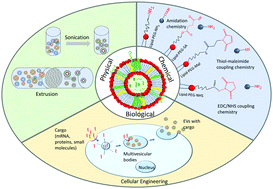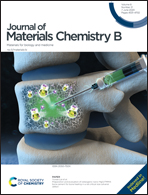Surface functionalization strategies of extracellular vesicles
Abstract
Extracellular vesicles (EVs) are lipid–protein bilayer vesicular constructs secreted to the extracellular spaces by cells. All cells secrete EVs as a regular biological process that appears to be conserved throughout the evolution. Owing to the rich molecular cargo of EVs with specific lipid and protein content and documented role in cellular communication, EVs have been exploited as a versatile agent in the biomedical arena, including as diagnostic, drug delivery, immunomodulatory, and therapeutic agents. With these multifaceted applications in the biomedical field, the functionalization of EVs to add diverse functionality has garnered rapid attention. EVs can be functionalized with an exogenous imaging and targeting moiety that allows for the target specificity and the real-time tracking of EVs for diagnostic and therapeutic applications. Importantly, such added functionalities can be used to explore EVs’ biogenesis pathway and their role in cellular communication, which can lead to a better understanding of EVs’ cellular mechanisms and processes. In this report, we have reviewed the existing surface functionalization strategies of EVs and broadly classified them into three major approaches: physical, biological, and chemical approaches. The physical approach of EV functionalization includes methods like sonication, extrusion, and freeze–thaw that can change the surface properties of EVs via membrane rearrangements. The biological approach includes genetically and metabolically engineering cells to express protein or cargo molecules of interest in secreted EVs. The chemical approach includes different facile click type chemistries that can be used to covalently conjugate the EV lipid or protein construct with different linker groups for diverse functionality. Different chemistries like thiol–maleimide, EDC/NHS, azide–alkyne cycloaddition, and amidation chemistry have been discussed to functionalize EVs. Finally, a comparative discussion of all approaches has been done focusing on the significance of each approach. The collective knowledge of the major approach of surface functionalization can be used to improve the limitation of one technique by combining it with another. An optimized surface functionalization approach developed accordingly can efficiently add required functionality to EVs while maintaining their natural integrity.



 Please wait while we load your content...
Please wait while we load your content...